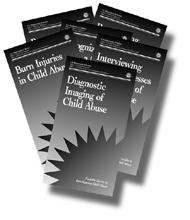| New Portable Guides to Investigating Child Abuse |
 |
OJJDP developed its award-winning series of Portable Guides to provide guidelines for investigating child abuse and neglect in a practical, easy-to-use format. The guides use straightforward, uncomplicated language, bulleted lists, tables, charts, checklists, and sample forms to present information useful not only to law  enforcement, but to social workers, prosecutors, and all other professionals involved in cases of child victimization. The original 11 guides in the series cover a wide range of topics, including physical abuse and homicide, burn injuries, child neglect and Munchausen syndrome by proxy, sexual abuse and exploitation, sexually transmitted diseases, diagnostic imaging, photo- documentation, and techniques for interviewing children. In response to the demand from the field for the Portable Guides, OJJDP is expanding the series. Two new guides are slated to be published within the next few months: Use of Computers in the Sexual Exploitation of Children and Forming a Multidisciplinary Team To Investigate Child Abuse. enforcement, but to social workers, prosecutors, and all other professionals involved in cases of child victimization. The original 11 guides in the series cover a wide range of topics, including physical abuse and homicide, burn injuries, child neglect and Munchausen syndrome by proxy, sexual abuse and exploitation, sexually transmitted diseases, diagnostic imaging, photo- documentation, and techniques for interviewing children. In response to the demand from the field for the Portable Guides, OJJDP is expanding the series. Two new guides are slated to be published within the next few months: Use of Computers in the Sexual Exploitation of Children and Forming a Multidisciplinary Team To Investigate Child Abuse.
The first of these guides addresses the challenges of investigating cases of child sexual exploitation that involve computers. The rapid development of computer technology has given sexual offenders who prey on children a new means of access to their intended victims and has complicated the efforts of law enforcement to apprehend these criminals. Use of Computers in the Sexual Exploitation of Children begins with a discussion of the behavioral characteristics of sexual exploiters of children and of how these traits manifest themselves in the use of computers. The next section offers guidelines for investigating these offenders, including advice on handling and analyzing the suspect's computer system. The guide concludes with a detailed discussion of the legal considerations that apply to the search and seizure of computer systems, with particular attention to search warrants.
The importance of using a multi-disciplinary team approach when investigating crimes against children is addressed in several of the original Portable Guides. Forming a Multi-disciplinary Team To Investigate Child Abuse discusses the need for the team approach in greater depth and offers guidelines for establishing and maintaining a multidisciplinary team. This guide covers the process of bringing team members together, developing a mission statement and investigative protocol, and evaluating the team. It also considers dealing with conflict within the team, promoting teamwork, and preventing burnout.
For more information on the Portable Guides series, see Portable Guides to Investigating Child Abuse: An Overview. This OJJDP Bulletin describes the series, offers a synopsis of each of the original 11 guides, and provides information on resources for training and technical assistance in handling child maltreatment cases. Use the order form to request a copy of the Bulletin.
|
Titles in This Series
To obtain a copy of any of the guides listed below, contact OJJDP's Juvenile Justice Clearinghouse by telephone at 800-638-8736 or through the Internet at [email protected].
| Use of Computers in the Sexual
Exploitation of Children, NCJ 170021
Forming a Multidisciplinary Team To
Investigate Child Abuse, NCJ 170020
Recognizing When a Child's Injury
or Illness Is Caused by Abuse,
NCJ 160938
Sexually Transmitted Diseases and Child Sexual Abuse, NCJ 160940
Photodocumentation in the Investigation of Child Abuse, NCJ 160939
Diagnostic Imaging of Child Abuse,
NCJ 161235 |
Battered Child Syndrome: Investigating Physical Abuse and Homicide,
NCJ 161406
Interviewing Child Witnesses and Victims of Sexual Abuse, NCJ 161623
Child Neglect and Munchausen
Syndrome by Proxy, NCJ 161841
Criminal Investigation of Child Sexual Abuse, NCJ 162426
Burn Injuries in Child Abuse, NCJ 162424
Law Enforcement Response to Child Abuse, NCJ 162425
Understanding and Investigating Child Sexual Exploitation, NCJ 162427 |
|
|

